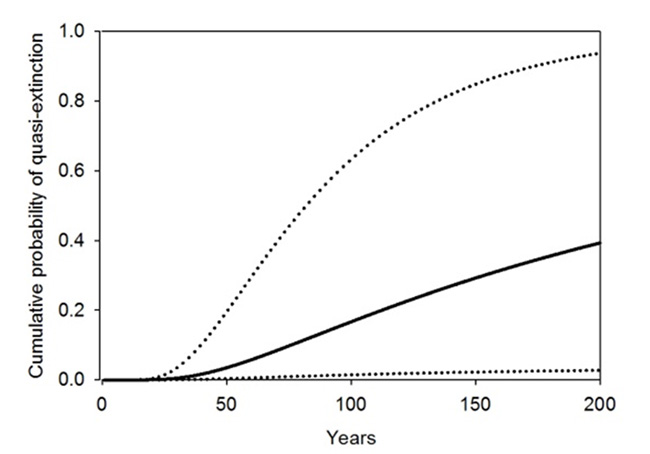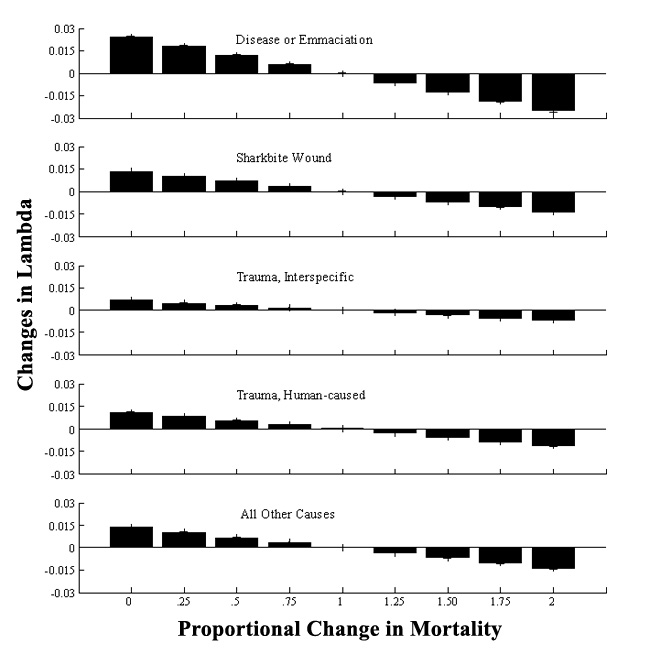« Prev Next »

The discipline of Conservation Biology has two general goals: the assessment and the management of biological diversity, which can be done at the level of populations, communities, and/or whole ecosystems. The first goal, assessment, involves defining the current state of a population, predicting its future, and identifying any threats to its persistence. For example, an assessment may involve estimating the number of individuals in a population, predicting future numbers, and evaluating the role of habitat loss and fragmentation in the population's current status and its predicted future (Lande 1988). The second goal, management, involves identifying and implementing solutions to ensure persistence (e.g., by determining where and how to establish a protected area) (Diamond 1976). Assessment and management are complementary goals essential for effective conservation. This article provides a general introduction to a set of assessment techniques used to predict the future of a population and identify threats to its persistence.
An important conservation objective is to prevent extinction. Conservation biologists emphasized early on that the process of extinction is best viewed as stochastic, meaning a process with random elements and thus not predictable with complete accuracy — much like tomorrow's weather (Hooper 1971, Shaffer 1981, Ginzburg et al. 1982). To understand extinction, ecologists have separated the different stochastic components affecting population dynamics. May (1973) first distinguished between demographic and environmental stochasticity, wherein the demographic aspect refers to intrinsic random processes, such as the chance that the last two surviving individuals are both males. The environmental stochastic component describes random changes in habitat, weather, etc. Later, Shaffer (1981) further distinguished genetic stochasticity, random changes in allele frequencies due to genetic drift, founder effects, or inbreeding (Thompson 1991).
Gilpin and Soulé (1986) conceived of population vulnerability analysis as an integrative approach to evaluate the full range of forces impinging on populations and to make determinations about viability and extinction. This concept constitutes the foundation of the developing method of population viability analysis (PVA). In the early 1990s, Thompson (1991) suggested three categories for PVAs:
- "Rules of thumb," such as minimum viable population size estimates;
- Analytical approaches, such as birth-and-death or genetic models; and
- Simulation approaches, which have been the most commonly employed method since the widespread availability of high-powered computers.
Today, the term PVA is commonly used to describe both the process and the set of quantitative tools aimed at estimating the probability that a population, or collection of populations, will persist for some particular time in a particular environment (Beissinger & McCullough 2002).
Persistence may be estimated in several different ways. A common estimate employed is the cumulative probability of extinction, or, more generally, of quasi-extinction (Figure 1). A quasi-extinction threshold reflects the fact that a population may be doomed to extinction even if there are still individuals alive. For example, for a sexually reproducing species the minimum number of individuals needed to persist is a single mating pair. However, given that there is a probability of mortality associated with each individual, the quasi-extinction threshold is generally larger than the actual population size. Other measurements of persistence include the mean time to some relevant threshold (e.g., time to a 50% population reduction) or the probability of reaching such a threshold within a defined period of time. For example, the Red List of the International Union for Conservation of Nature (IUCN), which assesses the conservation status of species, classifies a species as "critically endangered" if there is a projected probability of population reduction ≥80% within ten years or three generations, whichever is the longer.

Population Viability Analysis (PVA) Methods
Currently, there are many different approaches available to estimate persistence. These methods require different types of data and make different assumptions about the population under study. The simplest is a time-series PVA, which assumes all individuals in the population are identical. Thus, time-series PVAs use only estimates of the total number of individuals in a population over time to define an average growth trend and its variance (Dennis et al. 1991). Assuming the patterns of population growth (trend) and fluctuations (variance) will be the same in the future, time-series PVA can be used to assess the likelihood of persistence over time.
A second approach is the demographic PVA, which is based on estimates of age- or stage-specific vital rates, such as survival and reproduction, and their variances and covariances. Demographic PVAs do not assume all individuals are identical — clearly a reality — but do require considerably more data than time-series PVAs. On the plus side, demographic PVAs can go beyond estimating persistence, helping to identify the most vulnerable life history stages (Gilpin & Soulé 1986) and allowing scientists to ask questions about the probability of persistence under different management scenarios (Noss & Cooperrider 1994). For example, Gerber et al. (2003) developed a demographic model for sea otters in order to identify the relative efficacy of different investments to minimize alternative sources of mortality (Figure 2).

Time-series and demographic PVAs are the most commonly used approaches, but there are other methods based on patch occupancy data and complex individual-based models (see Morris & Doak [2002] for a more detailed presentation of these methods). In fact, the popularity of PVAs and the advent of personal computers have triggered the development of a number of packaged computer programs, including RAMAS (Ferson et al. 1988), VORTEX (Lacy et al. 1995), NEMESIS (Gilpin 1993), and ALEX (Possingham et al. 1992). Lindenmayer et al. (1995) and Mills et al. (1996) offer a thorough discussion of the relative merits of each of these programs. The diversity of conservation problems and threatened taxa highlight the value of a broad range of program options for estimating a population's viability (Lindenmayer et al. 1995). The potential problems with using these programs include: 1. the modeler may be affected by the "black box" syndrome, where they are not aware of exactly what the model is programmed to do and 2. it is generally most appropriate to develop programs that are specifically tailored to the goal of the modeling effort and the type of data available for the species.
Ultimately, which PVA approach to use should be decided based on which data are available and the goals of the analysis. Regardless of the method selected, the initial process of gathering available data and deciding which approach to apply is useful in itself, as it forces one to think explicitly about the fundamental processes affecting the population of interest and the relevant threats. One may also identify gaps in knowledge to target for future research.
Uncertainty and the Value of PVA
"Uncertainty is just about the only certainty in PVA."
—Steven Beissinger (Beissinger & McCullough 2002)
The value of PVAs has been questioned as a result of the difficulty in model parameterization (Mills et al. 1996), the lack of standardization between models (Lindenmayer et al. 1995), and the lack of reliability for risk classification (Taylor 1994). Inconsistency in methods and assumptions obscures scientists' ability to compare results from different PVAs. Data necessary to incorporate important processes (e.g., density dependence, stochasticity, spatial structure) are generally not available for threatened or endangered species. Unfortunately, the consequences of making assumption about these processes can be important (Ginzburg et al. 1982, Sabo et al. 2004). The principal problems of PVAs are summarized by Taylor & Ralls (1997):
- PVAs are single species techniques,
- PVAs omit risk sources that are difficult to estimate or detect, and
- PVAs project long into the future when conditions are difficult to predict.
Nevertheless, PVA can be a valuable tool as long as one embraces the uncertainty in parameter estimates, dynamic processes, and functional relationships. Even when the data and our understanding of the study system are excellent, our ability to make accurate predictions into the future will always be limited by our ignorance of future conditions. However, uncertainty does not mean that PVA predictions are pointless but rather serve to emphasize the importance of acknowledging limitations, exploring plausible scenarios, and being cautious in our conclusions and interpretations. For example, Boyce (1992) views PVA as an integral part of any species management plan, not as a method to estimate extinction probabilities but as a tool useful for comparing and prioritizing management actions. PVA cannot tell us if a population will still be around in fifty years but can help us understand the processes affecting population dynamics, identify data gaps, and evaluate the potential outcomes of different management or future condition scenarios.
The Future of PVA
PVAs have become a cornerstone of conservation biology, and it is likely that their importance will persist into the future. The precise role of PVAs in conservation biology is still emerging. While several detailed PVAs have now been conducted, the application of results to conservation decisions has been limited. PVA has typically been limited to cases that best fit Graham Caughley's "small population paradigm" (Caughley 1994, Groom & Pasqual 1996), but other potential applications exist. PVAs allow scientists and managers to test the sensitivity of a species' persistence to changes in life history parameters and to better define optimal objectives for recovery. Incorporating assumptions from life-table analysis may provide insight to understanding the causes of population declines (Crouse et al. 1987, York 1994). The approach can be particularly useful for analysis of fluctuating populations (Menges 1990).
Some of the most promising recent contributions to the development of PVA have been in the realm of Bayesian statistics and decision analysis (e.g., Evans et al. 2010). Bayesian approaches to PVA offer a precautionary approach to quantifying uncertainty (Hilborn et al. 1994). Bayesian statistical inference includes explicit assignment of prior probabilities, based on available data, to the outcomes of various null hypotheses. The results can then be used to calculate posterior probabilities of each hypothesis, which represent the range of uncertainty associated with any given parameter.
Summary
In conclusion, PVA represents one of the most valuable approaches that has emerged from the burgeoning field of Conservation Biology. While it is impossible to make precise predictions about the exact time to extinction, PVA has offered useful tools to estimate the relative risk of extinction, and to compare the efficacy of alternative management strategies. We anticipate that PVA will continue to capture the attention of conservation biologists and provide a practical interface between conservation science and practice.
References and Recommended Reading
Beissinger, S. R. & McCullough, D. R., eds. Population Viability Analysis. Chicago, IL: University of Chicago Press, 2002.
Dennis, B., Munholland, P. L., & Scott, J. M. Estimation of growth and extinction parameters for endangered species. Ecological Monographs 61, 115–143 (1991).
Diamond, J. M. Island biogeography and conservation: Strategy and limitations. Science 193, 1027–1029 (1976).
Gerber, L. R. et al. Mortality sensitivity in life-stage simulation analysis: A case study of Southern sea otters. Ecological Applications 14, 1554–1565 (2004).
Gonzalez-Suarez, M. et al. Incorporating uncertainty in spatial structure for viability predictions: A case study of California sea lions (Zalophus californianus californianus). Animal Conservation 9, 219–227 (2006).
Lande, R. Demographic models of the northern spotted owl (Strix occidentalis caurina). Oecologia, 75, 601–607 (1998).
Morris, W. F. & Doak, D. F. Quantitative Conservation Biology. Sunderland, MA: Sinauer Associates, 2002.
Thompson, G. G. Determining minimum viable populations under the Endangered Species Act. NOAA Technical Memorandum NMFS F/NWC-198, 1991.






























